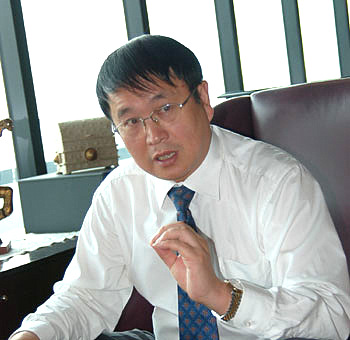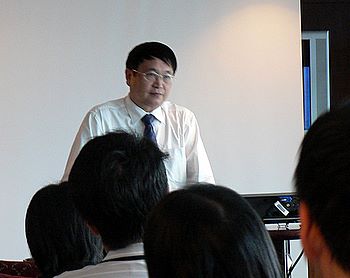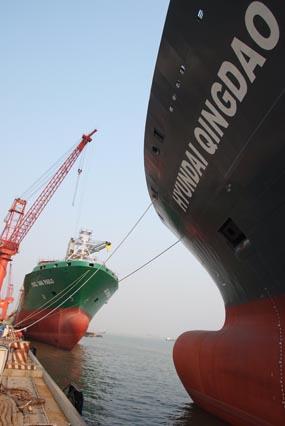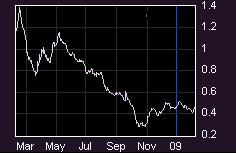 Ren Yuanlin, 54, chairman of Yangzijiang. Photo by Sim KihIF THINGS pan out the way he sees it, Mr Ren Yuanlin’s company will be stronger, bigger and rolling in cash over the next two or three years. Such optimism in the current gloom may be just pure hope, or delusion, or it may be derived from the confidence of a business leader who has survived past crises and gone on to achieve far bigger success.
Ren Yuanlin, 54, chairman of Yangzijiang. Photo by Sim KihIF THINGS pan out the way he sees it, Mr Ren Yuanlin’s company will be stronger, bigger and rolling in cash over the next two or three years. Such optimism in the current gloom may be just pure hope, or delusion, or it may be derived from the confidence of a business leader who has survived past crises and gone on to achieve far bigger success.The latter could be the case for Mr Ren, 54, chairman of Yangzijiang Shipbuilding, the fourth largest shipbuilder by revenue in China, which is the third largest shipbuilding country in the world.
He has chalked up 30-odd years in the shipbuilding industry, and lived through two massive shipbuilding downturns – during the recession of 1987 and the Asian financial crisis of 1997. He has seen his share of dead bodies - rival shipyards that could not survive.
Yangzijiang has survived, and grown from being a state-owned enterprise to a private entity and, last year, to a public-listed company on the Singapore Exchange. It is widely tracked – and invested in – by global fund managers because of its size (more than $8 billion in market capitalization in November 2007).
Because Yangzijiang’s shares became publicly quoted from last year, Mr Ren’s 29 percent stake in the company could be valued and it turned out that he was one of the richest men in China. Pegging his net worth at US$1.07 billion, Forbes magazine ranked him No. 60 richest in China last year.
Last year seems such a long time ago, as his net worth has since been slashed drastically by the slump in Yangzijiang’s stock price. As global financial markets sailed into a violent storm, Yangzijiang stock sank to 45 cents recently, even lower than its IPO price of 95 cents in April 2007.
More than 50 years old
 Briefing a roomful of analysts and fund managers at Tower Club recently. Photo by Leong Chan TeikMr Ren conceded that orders for new containerships, bulk carriers and other vessels that Yangzijiang builds would fall sharply, but he wanted to highlight also the resilience and business fundamentals of the company.
Briefing a roomful of analysts and fund managers at Tower Club recently. Photo by Leong Chan TeikMr Ren conceded that orders for new containerships, bulk carriers and other vessels that Yangzijiang builds would fall sharply, but he wanted to highlight also the resilience and business fundamentals of the company.To begin with, at more than 50 years old, Yangzijiang is just not like many of the new shipyards that have sprung up in China to meet hot demand in recent years for new ships. Some of the new shipyard owners are real estate companies who have recently ventured into this industry. With little experience and, worse of all, relatively thin order books, they could sink in the storm.
“When the going gets tough, look at the quality and experience of the management. My team has been through the 1987 and 1997 crises. It is one of the best shipbuilding management teams in China,” said Mr Ren.
Recently, in conjunction with the company’s announcement of its third-quarter results, he held a briefing for the first time for analysts and fund managers at the Tower Club – and met journalists.
The third-quarter results reflected an upward trend in performance that has not been broken – yet - by the global financial crisis. Revenue was up 139 per cent year-on-year to RMB 2 billion, while net profit shot up 114 per cent to RMB 475 million. Quarter on quarter, the figures were up 14 per cent and 41 per cent, respectively.
Yangzijiang’s revenue and net profit in that quarter alone approximately matched its entire year’s revenue and earnings in 2006, reflecting the business boom during the past two years.
The numbers have shot up because of the multi-year shipbuilding contracts.Yangzijiang’s order book recently stood at 164 vessels worth US$7.3 billion. This includes orders for six vessels worth US$81 million in the third quarter of 2008. All told,Yangzijiang’s yards will be busy until mid-2011 – a fact that Mr Ren could not emphasise enough.
Higher revenue in 2009
 Yangzijiang has an order book of US$7.3 billion.It is by no accident that the company had aggressively built up its order book. Mr Ren said that as far back as two years ago, when the company’s order book stood at around US$2.9 billion, the management had prepared for an industry down cycle, and figured that a three-year order book would enable the company to ride through it.
Yangzijiang has an order book of US$7.3 billion.It is by no accident that the company had aggressively built up its order book. Mr Ren said that as far back as two years ago, when the company’s order book stood at around US$2.9 billion, the management had prepared for an industry down cycle, and figured that a three-year order book would enable the company to ride through it.To address a bigger volume of work, the company expanded its production capacity. For more than 50 years, it had operated a 200,000 sq m yard in Jiangyin on the southern bank of Yangtze River in the Jiangsu province. In recent years, that yard had been operating at 100 per cent capacity.
Yangzijiang constructed a new yard in Jingjiang city, also in Jiangsu province, which was completed in mid-2007. This 793,000 sq m yard’s recent capacity utilization rate was 25 per cent, which will be raised over time as the company builds the ships already ordered. From 10 vessels in 2008, the new yard will construct 22 in 2009, 25 in 2010 and 30 in 2011 while the old yard continues to be 100 per cent utilised.
Given the secured business, the revenue of Yangzijiang can only rise in 2009 and 2010, said Mr Ren. Continuing with his case that Yangzijiang will be fine, he pointed out the company stands to enjoy cost savings with a fall in steel prices. Recently, steel price fell RMB 2,000 a tonne, translating into cost savings of RMB 600 million a year as Yangzijiang consumes about 300,000 tonnes of steel annually.
The global economic downturn has another blessing: Skilled workers are becoming more easily available and Yangzijiang, which currently employs about 10,000 workers, is looking to hire more of them.
While debt and refinancing are the biggest threats to corporates during the current crisis,Yangzijiang has been generously spared. Its cash and cash equivalents as at the end of September stood at RMB 5.5 billion. Its business generates a lot of cash: Operating cashflow for the first nine months of 2008 was RMB 3.4 billion.
It’s the deepening uncertainty of the future that the investment community fears. Orders for ships may be cancelled by Yangzijiang’s customers as the value of vessels in both the newbuild and secondary markets have plunged.
But Mr Ren would not rate that a significant possibility: “It hasn’t happened, and I don’t foresee it happening.”
He reeled off a list of customers’ names from Italy, Germany, Taiwan and China, citing them as being financially sound and having a credible track record but asked that it be kept confidential.
“We do thorough checks. We even want to know where our customers intend to deliver the vessels or who their charterers are. We want to be sure the clients are not speculators.”
That is not to say that order cancellations are unheard of although even industry insiders, according to a recent article by Lloyd’s List, find it almost impossible to discover exactly what is happening behind the scenes, with many of the discussions between shipowners and yards cloaked in secrecy.
Difficult for clients to cancel orders
Even if the buyers are of strong financial standing, they might back out of a shipbuilding order if it made financial sense to do so. But that is not likely at Yangzijiang, where pulling out of a firm order will prove very expensive.
Clients put down a 20 per cent deposit as soon as a vessel-building contract is signed. Another 20 per cent has to be guaranteed by a bank when work commences on a new ship.
This practice is sharply different from that of shipyards in South Korea and Japan which require deposits amounting to only 5-10 per cent. Each contract there is on average three times the value of Yangzijiang’s typical contract. Given those circumstances, ship buyers are more likely to cancel orders with the Korean yards if they face financing difficulties, argued Mr Ren.
In the unlikely event that a customer cannot find financing for a ship on which work has already begun substantially, Yangzijiang may help its client approach banks in China for loans in exchange for the ships as collateral.

Yangzijiang stock is down 62% from a year ago.
There are other interested parties. “Some ship companies in China have told us they would be interested to buy over from customers who are not able to raise financing.These are bargain hunters looking to buy at discounts.”
In their November report, DBS Vickers Securities analysts Pei Hwa Ho and Janice Chua noted that order flows had lost momentum for Yangzijiang, and they were concerned also about the risk of order cancellations. “Nonetheless, we acknowledge Yangzijiang as a well-managed yard which has demonstrated good earnings execution.”
Credit Suisse analyst Haider Ali is not entirely persuaded on Yangzijiang’s outlook, and set a target price of 40 cents for the stock based on just its 2008 expected book value. At the other end of the spectrum of analyst views, UBS Investment Research analyst Hubert Tang said that as an industry leader with strong financial strength, Yangzijiang can weather the downturn. “We maintain our ‘buy’ rating and 12-month price target of $1.30, based on 2.6x the expected 2009 book value.”
Mr Ren pointed to how Yangzijiang had navigated rough seas in the past. Prior to 1987, Yangzijiang focused on building barges for the China market. It subsequently diversified into building ships for Singapore, Hong Kong and Japanese clients. “Without the crisis, we wouldn’t have moved out of China.”
After 1997, when Asia fell to the financial crisis, Yangzijiang turned to the American and European markets, building containerships and bulk carriers. Now, as orders from the West dry up, Yangzijiang will turn its focus to markets such as the Middle East, Southeast Asia and China.
In China, especially, there is demand from players which have, until now, been chartering vessels from Western owners, instead of owning them. And there are opportunities for building other types of vessels, such as those for the oil and gas industry, said Mr Ren. As some shipyards in China and elsewhere die off, Yangzijiang expects its large orderbook to sustain it with rising profits, and lead to it become more dominant in its industry in the years ahead.
That is Mr Ren’s vision, and if there is anything that gives it some credence it is the massive share buyback that Yangzijiang has conducted. Since shareholders passed a share buyback resolution on 25 April 2008, the company has bought back 219.7 million shares, or 6.7 per cent of the issued share capital, at a cost of $117 million, as of Nov 23.
The almost daily buyback has led to, percentage-wise and in absolute dollars, one of the largest, if not the largest, buyback programmes on the Singapore Exchange in recent times. Mr Ren seemed to be signaling something – that his yard is strong and will overcome?
This article was recently published in Pulses magazine and is reproduced here with permission.
Related story: YANGZIJIANG'S chairman eschews the high life






